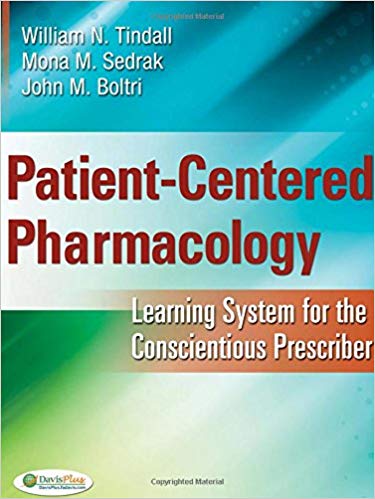Test Bank for Patient-Centered Pharmacology 1st by Tindall
$35.00 Original price was: $35.00.$26.50Current price is: $26.50.
Test Bank for Patient-Centered Pharmacology 1st by Tindall
This is completed downloadable of Test Bank for Patient-Centered Pharmacology 1st by Tindall

Product Details:
- ISBN-10 : 0803625855
- ISBN-13 : 978-0803625853
- Author: William N. Tindall PhD RPh (Author), Mona Sedrak PhD PA-C (Author), John M. Boltri MD FAAFP (Author)
Become a conscientious prescriber!
Using an integrated approach, this singular text focuses on patient first, helping you consider each patient as a unique individual with specific health concerns and characteristics that affect therapeutic decision making and drug efficacy.
Organized by disease state, this book will introduce you to general drug classifications and the medicinal agents most likely to be encountered in primary care settings. It encompasses the pharmacological principals, dosing, patient education, pharmacodynamics, and therapeutic parameters and indications for commonly prescribed drugs.
Table of Content:
Chapter 1. Conscientious and Rational Prescribing in the 21st Century Multiple Choice Identify the choice that best completes the statement or answers the question. 1. Which statement regarding herbals, vitamins, minerals, and food supplements is true? A. Herbals, vitamins, minerals, and food supplements are not regulated by the U.S. Food, Drug, and Cosmetic Act (FDCA). B. Manufacturers must prove the safety of their herbals, vitamins, minerals, and food supplements. C. Manufacturers must prove that their herbals, vitamins, minerals, and food supplements are free from adulteration. D. Manufacturers must prove the legitimacy of any claims they make about their herbals, vitamins, minerals, and food supplements. 2. Which amendment to the FDCA established the two classes of drugs: legend or prescriptio and over the counter? A. Durham-Humphrey Amendment (Prescription Drug Amendment) B. New Drug Application Amendment C. Health Education and Welfare Amendment D. Kefauer Harris Amendment 3. The package insert (PI) attached to a prescription drug contains all of the following informa except: A. U.S. Food and Drug Administration (FDA)-approved drug information. B. Highly detailed adverse effects and dosage information for the prescriber. C. Information in layman’s terms for the patient. D. Pharmacodynamic and pharmacokinetic drug information. 4. Which of the following best defines the term adulteration of drugs? A. Adding contaminants or anything not stated on a drug label B. Claiming a drug is a cure for a certain condition, such as cancer C. Advertising a drug for a poorly defined condition, such as miasma D. Claiming a drug is safe when its safety has not been established in preclinical trials 5. The majority of “off-label” or unapproved usages for drugs are prescribed for which patien groups? A. Pediatric patients and patients on chemotherapy B. Patients with neurologic diseases C. Obese patients D. Pregnant patients 6. The major goals of the Controlled Substances Act (CSA) include all of the following except A. Improving the manufacturing, distribution, prescribing, and dispensing of controlled substances by legitimate persons in the health-care sector. B. Providing research into issues of drug addiction and rehabilitation.
People Also Search:
patient-centered pharmacology
patient-centered pharmacology 1st by tindall
patient-centered pharmacology 1st by tindall test bank download pdf
patient-centered pharmacology 1st by tindall download scribd
Related products
Test Bank
Test Bank for Clinical Immunology and Serology A Laboratory Perspective, 3rd Edition: Stevens
Test Bank
Test Bank for Essentials of Business Law and the Legal Environment, 11th Edition: Richard A. Mann











